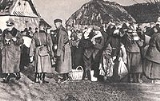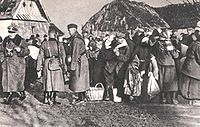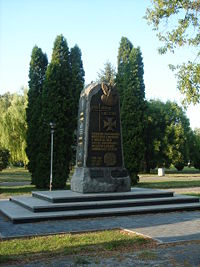
Zamosc Uprising
Encyclopedia


Armia Krajowa
The Armia Krajowa , or Home Army, was the dominant Polish resistance movement in World War II German-occupied Poland. It was formed in February 1942 from the Związek Walki Zbrojnej . Over the next two years, it absorbed most other Polish underground forces...
and Bataliony Chłopskie) against the forced expulsion of Poles from the Zamość
Zamosc
Zamość ukr. Замостя is a town in southeastern Poland with 66,633 inhabitants , situated in the south-western part of Lublin Voivodeship , about from Lublin, from Warsaw and from the border with Ukraine...
region (Zamość Lands, Zamojszczyzna) under the Nazi Generalplan Ost
Generalplan Ost
Generalplan Ost was a secret Nazi German plan for the colonization of Eastern Europe. Implementing it would have necessitated genocide and ethnic cleansing to be undertaken in the Eastern European territories occupied by Germany during World War II...
. The uprising lasted from 1942 to 1944.
The defense of the Zamość region is considered to be among the largest actions of the Polish resistance durning WWII
Polish resistance movement in World War II
The Polish resistance movement in World War II, with the Home Army at its forefront, was the largest underground resistance in all of Nazi-occupied Europe, covering both German and Soviet zones of occupation. The Polish defence against the Nazi occupation was an important part of the European...
.
German atrocities
In 1942, the ZamośćZamosc
Zamość ukr. Замостя is a town in southeastern Poland with 66,633 inhabitants , situated in the south-western part of Lublin Voivodeship , about from Lublin, from Warsaw and from the border with Ukraine...
region, due to its fertile black soil, was chosen for further German colonisation in the General Government
General Government
The General Government was an area of Second Republic of Poland under Nazi German rule during World War II; designated as a separate region of the Third Reich between 1939–1945...
as part of Generalplan Ost
Generalplan Ost
Generalplan Ost was a secret Nazi German plan for the colonization of Eastern Europe. Implementing it would have necessitated genocide and ethnic cleansing to be undertaken in the Eastern European territories occupied by Germany during World War II...
. In fact the Zamość region expulsions and colonization can be considered the beginning of the large-scale implementation of the Generalplan Ost. The city itself was to be renamed "Himmlerstadt" (Himmler City), later changed to Pflugstadt (Plow City), which was to symbolise the German "plow" that was to "plow the East". The German occupiers had planned the relocation of at least 60,000 ethnic Germans to the area before the end of 1943. An initial "test trial" expulsion
Population transfer
Population transfer is the movement of a large group of people from one region to another by state policy or international authority, most frequently on the basis of ethnicity or religion...
was performed in November 1941, and the whole operation ended in anti-partisan pacification
Pacification operations in German-occupied Poland
The pacification operations in German-occupied Poland was the use of military force and punitive measures conducted during World War II by Nazi Germany with the goal of suppressing any Polish resistance....
operations combined with expulsions in June/July 1943 which were codenamed Wehrwolf Action I and II.
Over 110,000 Polish people from approximately 300 villages were expelled
Expulsion of Poles by Germany
The Expulsion of Poles by Germany was a prolonged anti-Polish campaign of ethnic cleansing by violent and terror-inspiring means lasting nearly a century. It began with the concept of Pan-Germanism developed in early 19th century and continued in the racial policy of Nazi Germany asserting the...
to make room for German (and to a lesser extent, Ukrainian) settlers as part of Nazi plans for establishment of German colonies in the conquered territories (Generalplan Ost
Generalplan Ost
Generalplan Ost was a secret Nazi German plan for the colonization of Eastern Europe. Implementing it would have necessitated genocide and ethnic cleansing to be undertaken in the Eastern European territories occupied by Germany during World War II...
). Some villagers were resettled in the Warsaw
Warsaw
Warsaw is the capital and largest city of Poland. It is located on the Vistula River, roughly from the Baltic Sea and from the Carpathian Mountains. Its population in 2010 was estimated at 1,716,855 residents with a greater metropolitan area of 2,631,902 residents, making Warsaw the 10th most...
or Lublin
Lublin
Lublin is the ninth largest city in Poland. It is the capital of Lublin Voivodeship with a population of 350,392 . Lublin is also the largest Polish city east of the Vistula river...
area, but about 50,000 of those expelled were sent as forced labour to Germany, and some others were sent to the Nazi concentration camps
Nazi concentration camps
Nazi Germany maintained concentration camps throughout the territories it controlled. The first Nazi concentration camps set up in Germany were greatly expanded after the Reichstag fire of 1933, and were intended to hold political prisoners and opponents of the regime...
. Some villages were simply razed and inhabitants executed. Additionally almost 30,000 children were kidnapped by German authorities
Kidnapping of Polish children by Nazi Germany
Kidnapping of Eastern European children by Nazi Germany , part of the Generalplan Ost , involved taking children from Eastern Europe and moving them to Nazi Germany for the purpose of Germanization, or conversion into Germans....
from their parents for potential Germanisation
Germanisation
Germanisation is both the spread of the German language, people and culture either by force or assimilation, and the adaptation of a foreign word to the German language in linguistics, much like the Romanisation of many languages which do not use the Latin alphabet...
. Only 800 of them were found and sent back to Poland after World War II.
Polish resistance
Local people resisted the action with great determination; they escaped into forests, organised self-defence, helped people who were expelled, and bribed kidnapped children out of German hands. Units of Polish resistance (primarily of Armia KrajowaArmia Krajowa
The Armia Krajowa , or Home Army, was the dominant Polish resistance movement in World War II German-occupied Poland. It was formed in February 1942 from the Związek Walki Zbrojnej . Over the next two years, it absorbed most other Polish underground forces...
and Bataliony Chłopskie) as well as elements of Soviet partisans
Soviet partisans
The Soviet partisans were members of a resistance movement which fought a guerrilla war against the Axis occupation of the Soviet Union during World War II....
and the pro-Soviet Gwardia Ludowa
Gwardia Ludowa
Gwardia Ludowa or GL was a communist armed organisation in Poland, organised by the Soviet created Polish Workers Party. It was the largest military organization which refused to join the structures of the Polish Underground State. It was created in 1942 and in 1944 it was incorporated by the...
helped to evacuate Polish civilians and assaulted German colonists and forces in the region. In December 1942 one of the first large-scale partisan battles of World War II occurred in the region. The resistance forces numbered several thousand forest fighters. The first phase of the resistance took place from December 1942 to February 1943; the Germans then lessened their activities for a few months but counterattacked in June, with major anti-partisan actions and terror directed against the civilian population (Wehrwolf Action I and II).
Nonetheless after several major battles between the partisans and the German units (the most notable being the battles of Wojda, Róża
Roza
Roza is an urban locality in Korkinsky District of Chelyabinsk Oblast, Russia. Population: It was founded on October 1, 1981. The official holiday of Roza is observed on the last Sunday of August....
, Zaboreczno
Zaboreczno
Zaboreczno is a village in the administrative district of Gmina Krynice, within Tomaszów Lubelski County, Lublin Voivodeship, in eastern Poland. It lies approximately north-west of Tomaszów Lubelski and south-east of the regional capital Lublin....
, Długi Kat, Lasowce and Hrubieszów
Hrubieszów
Hrubieszów is a town in southeastern Poland, with a population of 18,661 . It is the capital of Hrubieszów County. Since 1999 Hrubieszów has been part of Lublin Voivodeship . Earlier, 1975–98, it had been part of Zamość Province...
as well as the Battle of Osuchy
Battle of Osuchy
The Battle of Osuchy was one of the largest battles between the Polish resistance and Nazi Germany in occupied Poland during World War II, a part of the Zamość Uprising...
), the Germans had to halt the action and in the end very few German settlers were brought to the area. Until the middle of 1943, the Germans managed to settle 8,000 colonists; the number increased by a couple of thousand in 1944. The increasing harassment from the partisans meant that the Germans began to lose the control of the region as early as the spring of 1943.
In the first half of 1944 Polish civilians and resistance was also attacked by Ukrainian units of the Ukrainian Insurgent Army (see massacres of Poles in Volhynia
Massacres of Poles in Volhynia
The Massacres of Poles in Volhynia and Eastern Galicia were part of an ethnic cleansing operation carried out by the Ukrainian Insurgent Army West in the Nazi occupied regions of the Eastern Galicia , and UPA North in Volhynia , beginning in March 1943 and lasting until the end of...
). Nonetheless by the summer of 1944 the Polish partisans, based in the large forests of the region had taken control of most of the countryside, limiting German control to the major towns. In the summer of 1944 Germans again initiated major anti-partisan operations (Sturmwind I and Sturmwind II) which resulted in the battle of Osuchy
Battle of Osuchy
The Battle of Osuchy was one of the largest battles between the Polish resistance and Nazi Germany in occupied Poland during World War II, a part of the Zamość Uprising...
(one of the largest battles between the Polish resistance and Nazi Germany), with the insurgents sustaining heavy casualties. However soon afterwards, in July, the remaining Polish units took part in the nationwide Operation Tempest
Operation Tempest
Operation Tempest was a series of uprisings conducted during World War II by the Polish Home Army , the dominant force in the Polish resistance....
and managed to liberate several towns and villages in the Zamość region. The Germans, pressured by the advancing Red Army
Red Army
The Workers' and Peasants' Red Army started out as the Soviet Union's revolutionary communist combat groups during the Russian Civil War of 1918-1922. It grew into the national army of the Soviet Union. By the 1930s the Red Army was among the largest armies in history.The "Red Army" name refers to...
, were forced to abandon the region.
Remembrance
Several monuments, museums and cemeteries have been raised in the area over time. In the People's Republic of PolandPeople's Republic of Poland
The People's Republic of Poland was the official name of Poland from 1952 to 1990. Although the Soviet Union took control of the country immediately after the liberation from Nazi Germany in 1944, the name of the state was not changed until eight years later...
the actions of the communist Armia Ludowa
Armia Ludowa
Armia Ludowa was a communist partisan force set up by the Polish Workers' Party during World War II. Its aims were to support the military of the Soviet Union against German forces and aid the creation of a pro-Soviet communist government in Poland...
were emphasized at the expense of those of the non-communist resistance.
A recent Polish documentary dedicated to the uprising has been recognized in the New York Festivals of 2008 with a bronze medal.
External links
- German order, dated 22 November 1943, for the ethnic cleansing of the Zamosc Lands (issued by Odilo GlobocnikOdilo GlobocnikOdilo Lotario Globocnik was a prominent Austrian Nazi and later an SS leader. He was an acquaintance of Adolf Eichmann, who played a major role in the extermination of Jews and others during the Holocaust...
) Andrzej Jerzy Krukowski, POWSTANIE ZAMOJSKIE 1942–1943 Bitwa o Zamojszczyznę Zygmunt Puźniak, POWSTANIE ZAMOJSKIE CZY JÓZEFOWSKIE?, Tygodnik Zamojski, 27 luty 2008 Powstanie Zamojskie, TVP 3 Lublin, 31 October 2006
Further reading
- Janusz Gmitruk, Powstanie Zamojskie, Muzeum Historii Polskiego Ruchu Ludowego, 2003, ISBN 83-87838-69-1
- Jan Grygiel, Związek Walki Zbrojnej i Armia Krajowa w Obwodzie Zamojskim 1939–1944, Polskie Wydawnictwo Naukowe 1985
- Walki oddziałów ZWZ-AK i BCh Inspektoratu Zamojskiego w latach wojny 1939–1944, Związek Żołnierzy Armii Krajowej Okręg Zamość 1990

